The Taliban government has been pressing for the extraction of copper from Afghanistan's Mes Aynak mine as an additional revenue source, but the mine is located at an ancient historical site, which worries some archaeologists.
The mine is more than 40 kilometers southeast of Kabul in the Logar province. The area is considered one of the largest untapped copper mines in the world, with deposits worth at least $50 billion.
The Mes Aynak mine is at the site of an ancient Buddhist city of the same name along the Silk Road. Structures and artifacts uncovered at the site lead archeologists to believe that 2,000 years ago, the residents mined copper, with evidence of ancient smelting workshops.
But the Taliban are eager for the mine to start operating to offset international sanctions, observers say. The Taliban are "in need of money," Azarakhsh Hafizi, an economist and former head of the international relations committee at Afghanistan's Chamber of Commerce and Industries, told VOA.
Afghanistan has been dependent on international aid since the 1920s when development and modernization started in the country, Hafizi said, but now that international funding is cut off, the Taliban are looking for new revenue sources.
"Afghanistan's export was worth $2 billion in the past year, which mainly came from the minerals," Hafizi said.
The artifacts hurdle
During a recent visit to Afghanistan by an official from the Metallurgical Corporation of China, the Taliban minister for mines and petroleum, Shahabuddin Delawar, described the project as "important and vital," and said the extraction of the mine's copper is "one of the top priorities" for the Taliban.
The Taliban are "committed to beginning the work on the project as soon as possible so jobs can be created for the people," the Pajhwok News Agency, an independent news outlet, reported Delawar saying last month.
The MCC official told the Taliban the "presence and relocation" of the historical objects at the site is the main hurdle in the exploitation of the mine, according to Pajhwok and a post by the Ministry of Mines and Petroleum of the Taliban on X, the platform formerly called Twitter.
The Taliban said they formed a committee to work on the relocation of the artifacts. However, concerns remain about the preservation of the historical site.
"It is impossible," said Noor Agha Noori, the former director of Afghanistan's Institute of Archaeology, adding that "It is an ancient city; how can the city be moved and relocated? ... It has its own structures, walls, graveyard and water system."
Noori told VOA that the objects discovered in the site belong to the Buddhist era from the 1st to 7th century, but "there are signs that show some of the artifacts can go back 1500 BC."
"Archaeologists would need decades to discover all the artifacts," he added.
Noori and other archeologists are concerned about the proper protection of the artifacts because when the Taliban were in power in 2001, they blew up two giant Buddha statues in the central Bamiyan province and destroyed many statues and artifacts in the Kabul Museum.
Noori said 15 years ago when the contract to extract the mine was signed, only a preliminary survey was conducted, and "it was not clear that there would be many historical artifacts or an ancient city."
In 2007, the former Afghan government signed a $3 billion contract with a Chinese consortium, consisting of MCC and the Jiangxi Copper Corporation, to extract the Mes Aynak copper.
In addition to paying royalties to the Afghan government, the contract stipulated that the Chinese consortium needed infrastructure, including a railway and a power plant.
But the work never started because of security issues in the province and the discovery of the artifacts.
Mes Aynak recommendations
Noori said that based on a survey by national and international archaeologists conducted over years, some recommendations were made to the former government to bring changes to the contract to preserve the site while paving the way for the extraction of the copper.
"We recommended that the central part of the mine should be extracted via underground mining to preserve the ancient city. In the western part, there were not that many artifacts so it can be extracted from an open pit," Noori said.
He added that in the case of open-pit extraction, "about 50% of the artifacts could get destroyed."
The Chinese company prefers open-pit extraction of the mine, said Ainuddin Sadaqat, the Afghanistan National Museum's chief curator.
He told VOA the recommendations to do underground extraction were shared with the Chinese officials in a meeting last year, but the company's delegation said that "it was costly."
Sadaqat said government agencies and some NGOs that are working to protect the historical site are preparing for the relocation of the artifacts.
"The preliminary work is underway, but it is still not clear when the relocation of the historical artifacts would take place," he added.
Sadaqat said while many of the smaller artifacts, such as jewelry and dishes, have already been transported to the National Museum, the larger objects are going to be moved to a local museum in the area.
Taliban response
In the past two years, the Taliban government has taken steps to protect the historical sites, Mohammad Hasib Nasimi, Director of Preservation and Restoration of Historical Monuments in the Ministry of Information and Culture of Afghanistan, told VOA.
"There are positive changes. We have been working on the restoration and protection of the historical sites," Nasimi added.
Haroon Hakimi from VOA's Afghan Service contributed to this report, which originated in VOA's Afghan Service.













